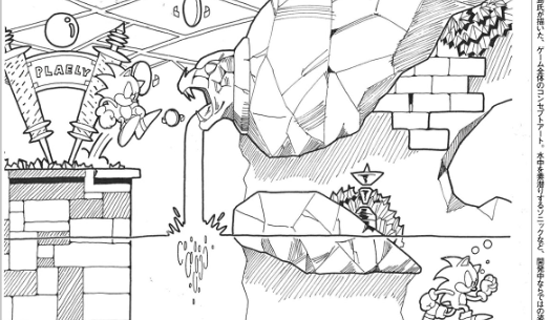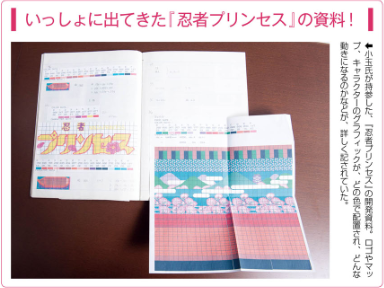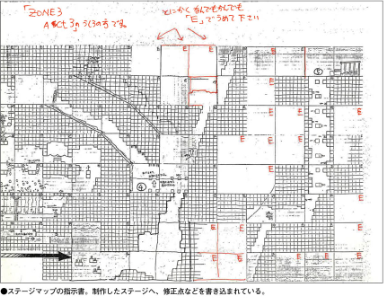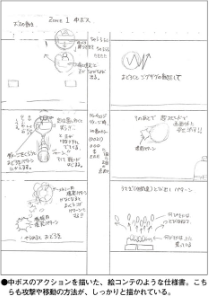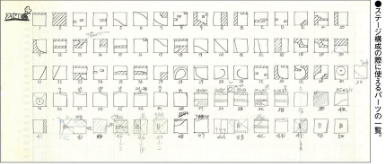Sega has an extensive library of games, from arcade to home console. A first-hand witness to this history of celebrated creators, Rieko Kodama has worked with them all from past to present. Not only do we hear anecdotes and stories, but we also get to see some unbelievably rare materials from back in the day…!
Rieko Kodama (Sega Games Producer)
Having entered Sega as a designer in 1984, she worked on such arcade games as Sega Ninja (Shinobi Princess). Afterward she was involved with various home console titles, and served as director for Magic Knight Rayearth on the Sega Saturn.
 Secret Stories of A Famous Title Revealed!
Secret Stories of A Famous Title Revealed!
You started out as a designer, but what sort of work were you doing around the time of the Mega Drive?
(Kodama) Around the time of the Master System I was just completing tasks given to me by senior employees. But from the time that we began developing titles for the Mega Drive, I started doing more work involving my strong points of creating backgrounds and world designs for many different titles. I also did character design for the first time, having worked on the character animation for Sega Ninja (Shinobi Princess). I kept some materials around from that, so I’ve brought them with me today.
I never would have thought these sorts of materials would still be around!
(Kodama) I was taught by a senior employee that I should always keep materials like this around, as soon as I joined the company. I just thought they’d just be a good source of information. I never guessed the day would come when they’d be useful in a situation like this (Laughs)
We’re very grateful for that lesson. After Sega Ninja you switched over to design for home console games, right?
(Kodama) That’s right. There were several designers on Phantasy Star, including me. Among them was Naoto Oshima, who would go on to design Sonic later. And Yuji Naka was the lead programmer, who also helped create Sonic The Hedgehog. Back then we developed games with teams of around 10 people, and we were very boisterous while doing so.
You were involved in the development of Sonic The Hedgehog, right?
(Kodama) I came in midway through, but I helped with background design. At the time I’d jump in and help with design work on projects that were behind schedule, and there were a lot of cases where I would leave a project partway through and move onto the next one. But for Sonic The Hedgehog, I was on the project right up until the end. The designers setup all of the stage collision detection. I remember going to a nearby family restaurant for a late lunch, after we finished the work. I just happened to find some materials from that as well, so I brought them along too.
Huh!? Wouldn’t these be considered extremely valuable…?
(Kodama) They were given to me back then as development materials. I came into the project midway through, so I think everyone made up these materials to help get me up to speed. Mr. Oshima oversaw all of the design himself, and very precisely architected the world’s look and feel. It really was a fun job.
Sonic The Hedgehog was a bit hit after that…but did that result in a big environmental change for the development teams?
(Kodama) Not much of anything changed for me. Mr. Naka and Mr. Yasuhara (Planner Hirokazu Yasuhara) from Sonic Team starting talking about how they should make a game with some western influence, since Sonic was such a big hit overseas. And that’s why they worked overseas for Sonic The Hedgehog 2.
What were you working on while everyone else was overseas?
(Kodama) Up until that point there had been female employees who were my seniors, but they’d all quit. And that ended up leaving me in the lead designer position. So just like with Sonic The Hedgehog, I went in and helped on all sorts of different games. That led to me being involved in all sorts of different Mega Drive titles. One that I remember very well is “Advanced Daisenryaku: Doitsu Sakusen”. The planner was a military fanatic, so I was trying to work on all of these aircrafts that I’d never seen before in my life. They weren’t published in any reference books, so I had to buy and assemble all of these plastic models of them. And so their appearances in the game were based on those models. And in an unrelated note, I remember being praised for being good at putting together plastic models.
Hahaha (Laughs). Then, do you remember being particularly amazed by anyone that you worked with?
(Kodama) Mr. Naka, of course. I was very much an amateur at programming, so I’d tell him what I wanted to do from a design perspective, and make all sorts of unreasonable requests. He would always do his best to program them for me. One instance that I remember in particular was during Phantasy Star. When I finished the design work, Mr. Naka said “Let’s include a portrait of the whole player party! That will definitely make the players happy”. At that point it was all I could do to keep up with my work load, but I was able to free up some time and include the portrait that appears in the game’s ending. Actually Phantasy Star was just released on 10/31 as a part of the Sega Ages series. The lead programmer of that port saw Naka’s code, and was apparently very puzzled about how he was able to cram in such an unbelievable amount of data (Laughs)
Why Was Mega Drive Software So Fascinating?
Which Mega Drive title did you first work on?
(Kodama) Altered Beast (Juuouki). Since it was a title that had already been released in arcades, I re-drew everything based on the original graphic data. Since the number of colors that can be used are different between the Mega Drive and an arcade game, I focused on getting it as close to the original as possible. We began development on Altered Beast before the Mega Drive had been completed, so there was this giant prototype dev kit sitting there, that was about 1 meter by 2 meters. When someone mentions the Mega Drive, that prototype dev kit is still what I picture (Laughs)
Were Mega Drive games easily to develop from a design standpoint?
(Kodama) There were a lot more colors available than there were on the Master System, and parallax scrolling was possible. So that allowed for more three-dimensional design. But since I already had experience with arcade game development, I felt like this was home console hardware finally getting close to arcade hardware. I feel like that arcade game development experience that I got back when I was a new employee was a very big deal for me.
I get the impression that Mega Drive mania was a strong and intense thing, but why do you think that was?
(Kodama) The development staff was young at the time, and we were making games in a very exciting atmosphere…maybe that’s why? (Laughs) No matter what we made, it was going to be something new. And we strived to make them all things that would surprise everyone. It wasn’t the mature environment that things are nowadays, so I think it was very easy to create something that was new. I think it may have brought out the passion within enthusiasts because we were able to make the things we wanted, exactly how we wanted to make them.
The upcoming Mega Drive Mini may bring with it that feeling of being an edgy product as well.
(Kodama) Maybe so. I’d certainly like for all of the young people out there to play it.
The Days of Getting Excitement From the Software of Nintendo, and Other Companies
You’ve served as a director on several titles, but did you have an interest in that sort of job from the very beginning?
(Kodama) There was no real director position back when I was working on Phantasy Star IV, so I wasn’t really thinking about it that way. Actually my boss at the time asked me “How about you try making an RPG?”, so I was the team leader.
Is it because back then everyone did multiple jobs?
(Kodama) That’s right. The composition of the Phantasy Star IV team was distinct in that it didn’t have a planner. Writing the scenario text, game balancing…basically everything but the programming was done by the designers. I think that someone with the job of designer creates the scenario and world feel as they’re drawing, and is good at giving a game color by taking an extensive view of everything. And I suppose in that case the most amazing person would be someone who could both draw and program (Laughs)
Were they any pieces of Mega Drive software from other companies that made you think “They outdid us!”?
(Kodama) Land Stalker by Climax Entertainment. It felt like a western game while having a design that worked with super-deformed characters. After that game came out, requests to use that sort of style started coming from upper management. I remember it being a particularly high hurdle for us to get over. Also I personally was very envious of Lunar: The Silver Star Story by Game Arts. I think I just wanted to create an RPG with TV anime-like graphics and scenery too.
By the way, were you aware of any particular titles from the Mega Drive’s rival console, the Super Famicom?
(Kodama) The Super Famicom could use intermediate colors and transparencies that the Mega Drive couldn’t, because of the power of the hardware. More than seeing it as a rival console, I was jealous of it. So I did all sorts of research on how to simulate those kind of beautiful graphics.
What specifically did you research?
(Kodama) I thought that the best quality pixel graphics at that time were in the PC game industry, so I worked on some PC games as well.
Speaking of the best quality pixel graphics at that time, did you work on “sexy” PC games?
(Kodama) I’ll leave that to your imagination (Laughs)
